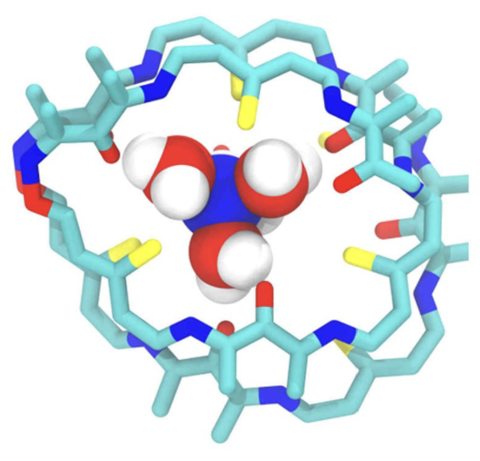Sulfur-Containing Foldamer-Based Artificial Lithium Channels

Abstract Unlike many other biologically relevant ions (Na+, K+, Ca2+, Cl-, etc) and protons, whose cellular concentrations are closely regulated by highly selective channel proteins, Li+ ion is unusual in that its concentration is well tolerated over many orders of magnitude and that no lithium-specific channel proteins have so far been identified. While one naturally evolved primary pathway for Li+ ions to traverse across the cell membrane is through sodium channels by competing with Na+ ions, highly sought-after artificial lithium-transporting channels remain a major challenge to develop. Here we show that sulfur-containing organic nanotubes derived from intramolecularly H-bonded helically folded aromatic foldamers of 3.6 Å in hollow cavity diameter could facilitate highly selective and efficient transmembrane transport of Li+ ions, with high transport selectivity factors of 15.3 and 19.9 over Na+ and K+ ions, respectively.
3D view of the all-atom model P15 channel at the beginning of the simulation. The left panel shows a rotating side view, the right panel shows a zoom-in view passing inside the channel. C (turquoise), N (blue) S (yellow), and O (red) atoms around the central lumen of the channel are shown in using spheres whereas the rest of the non-hydrogen atoms are shown in licorice representation.
Equilibrium MD simulation of P15 channel in aqueous solution. One μs long MD simulation trajectories of system 1 (left) and system 2 (right) showing a cut-away side view of the simulated systems. The movie illustrates the water (top) and (bottom) ion permeation through the P15 channel. The atoms of the channel around the lumen are shown in surface representation, the water molecules present inside the channel are shown as red (O) and white (H) spheres. Ions present inside the channel, Li+ (blue), Na+ (yellow) and K+ (tan) are shown using spheres. The side chain of the channel, rest of the water and ions are not shown for the sake of clarity. The top row shows water and ion permeation through the channel in the equilibrium MD simulation, while in the same simulation trajectories shown in the bottom row water molecules are not shown for the sake of visualizing ion dynamics inside the channel.